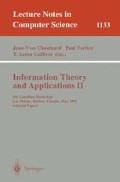Abstract
To select a suitable feature vector extracted from the interested character for the purpose of classification is essential in the design of a character recognition system. Moment descriptors have been developed as features in pattern recognition since Hu[14] first introduced the moment method. Describing a character with moments means that global properties of the character are used rather than local properties. This nature makes the method of moments a proper candidate for Chinese character recognition system. In this paper, new Legendre moment spaces for Chinese character recognition are proposed which provide significant improvements in terms of Chinese character recognition.
Preview
Unable to display preview. Download preview PDF.
References
Y.S. Abu-Mostafa and D. Psaltis, Recognitive aspects of moment invariants, IEEE Trans. Pattern Anal. Machine Intell., Vol. PAMI-6, pp. 698–706, Nov. 1984.
Y.S. Abu-Mostafa and D. Psaltis, Image normalization by complex moments, IEEE Trans. Pattern Anal. Machine Intell., Vol. PAMI-7, pp. 46–55, Jan. 1985.
F.L. Alt, Digital pattern recognition by moments, J. Assoc. Computing Machinery, Vol. 9, pp. 240–258, 1962.
R.L. Andersson, Real time gray scale video processing using a moment generating chip, IEEE Journal of Robotics and Automation, Vol. RA-1, No. 2, June 1985.
S.O. Belkasim, M. Shridhar and M. Ahmadi, Pattern recognition with moment invariants: a comparative study and new results, Pattern Recognition, Vol. 24, No. 12, pp. 1117–1138, 1991.
J.F. Boyce and W.J. Hossack, Moment invariants for pattern recognition, Pattern Recognition Lett., Vol. 1, no. 5–6, pp. 451–456, July 1983.
R. Courant and D. Hilbert, Methods of Mathematical Physics, Vol. I. New York: Interscience, 1953.
P.J. Davis and P. Rabinowitz, Methods of Numerical Integration, Academic Press, New York, 1975.
R.O. Duda and P.E. Hart, Pattern Classification and Scene Analysis, Wiley, New York, 1973.
K.J. Dudani, K.J. Breeding, and R.B. McGhee, Aircraft identification by moment invariants, IEEE rans. Comput. Vol. C-26, pp. 39–46, Jan. 1977.
V.K. Govindan and A.P. Shivaprasad, Character recognition — a review, Patt. Recogn., Vol. 23, no. 7, pp. 671–683, 1990.
M. Hatamian, A Real-time two-dimensional moment generating algorithm and its single chip implementation, IEEE Trans. Acoust. Speech Signal Process. ASSP-34, 1986, pp. 99–126.
M.K. Hu, Pattern recognition by moment invariants, proc. IRE 49, 1961, 1428.
M.K. Hu, Visual problem recognition by moment invariant, IRE Trans. Inform. Theory, Vol. IT-8, pp. 179–187, Feb. 1962.
A.K. Jain, Fundamentals of Digital Image Processing, Prentice-Hall, 1989.
S. X. Liao, Image Analysis by Moments, Ph.D. dissertation, The University of Manitoba, 1993.
S. X. Liao and M. Pawlak, On image analysis by moments, IEEE Trans. PAMI, Vol. 18, No. 3, pp. 254–266, March, 1996.
Chin Lu, A survey on Chinese computing research, Hong Kong Computer Journal, Vol. 9, No. 12, December 1993.
M. Pawlak, On the reconstruction aspects of moment descriptions, IEEE Symposium on Information Theory, San Diego, January 1990.
M. Pawlak, On the reconstruction aspects of moment descriptors, IEEE Trans. Information Theory, Vol. 38, No. 6, pp. 1698–1708, November, 1992.
M. Pawlak and X. Liao, On Image Analysis via Orthogonal Moments, Vision Interface '92, pp. 253–258, May, 1992.
M. Pawlak and X. Liao, On image analysis by orthogonal moments, 11th IAPR International Conference On Pattern Recognition, pp. 549–552, Aug.30–Sept.3, 1992.
M. Pawlak and S. X. Liao, On digital approximation of moment descriptors, Machine GRAPHICS & VISION Vol. 3, Nos. 1/2, pp. 61–68, 1994.
R.J. Prokop and A.P. Reeves, A survey of moment-based techniques for unoccluded object representation and recognition, Graphical Models And Image Processing, Vol. 54, No. 5, September, pp. 438–460, 1992.
William H. Press, Brian P. Flannery, Saul A. Teukolsky, and William T. Vetterling, Numerical Recipes in C, Cambridge University Press, 1988.
T.H. Reiss, The revised fundamental theorem of moment invariants, IEEE Trans. Pattern Anal. Machine Intell., Vol. PAMI-13, No. 8, August 1991, pp. 830–834.
F.W. Smith and M.H. Wright, Automatic ship photo interpretation by the method of moments, IEEE Trans. Comput., Vol. C-20, pp. 1089–1094, Sept. 1971.
M.R. Teague, Image analysis via the general theory of moments, J. Optical Soc. Am., Vol. 70, pp. 920–930, August 1980.
C.H. Teh and R.T. Chin, On image analysis by the methods of moments, IEEE Trans. Pattern Anal. Machine Intell., Vol. PAMI-10, pp. 496–512, July 1988.
Yu. V. Vorobyev, Method of Moments in Applied Mathematics, New York, Gordon and Breach Science Publishers, 1965.
Author information
Authors and Affiliations
Editor information
Rights and permissions
Copyright information
© 1996 Springer-Verlag Berlin Heidelberg
About this paper
Cite this paper
Liao, S.X., Pawlak, M. (1996). Chinese character recognition via orthogonal moments. In: Chouinard, JY., Fortier, P., Gulliver, T.A. (eds) Information Theory and Applications II. CWIT 1995. Lecture Notes in Computer Science, vol 1133. Springer, Berlin, Heidelberg. https://doi.org/10.1007/BFb0025151
Download citation
DOI: https://doi.org/10.1007/BFb0025151
Published:
Publisher Name: Springer, Berlin, Heidelberg
Print ISBN: 978-3-540-61748-8
Online ISBN: 978-3-540-70647-2
eBook Packages: Springer Book Archive

